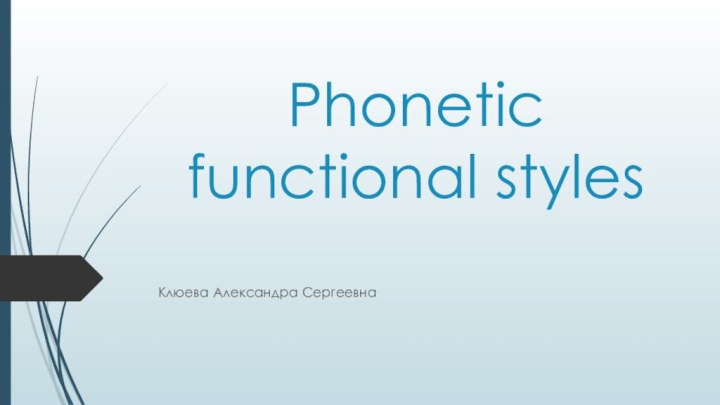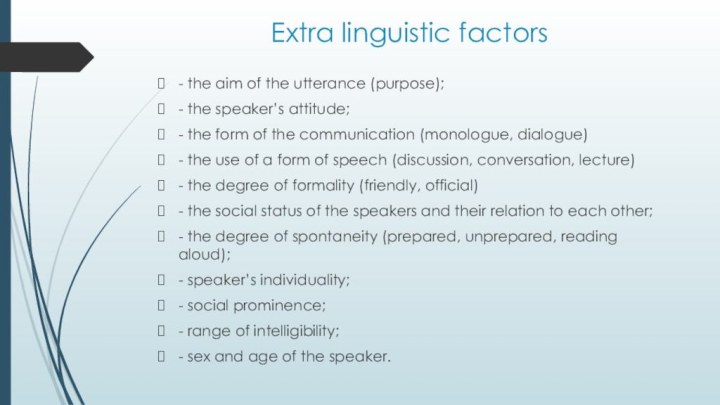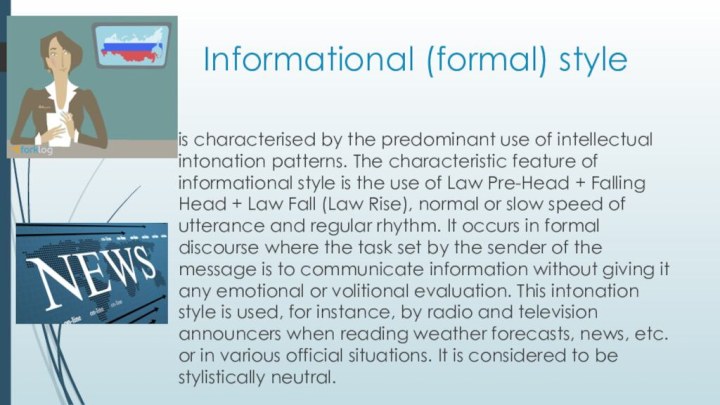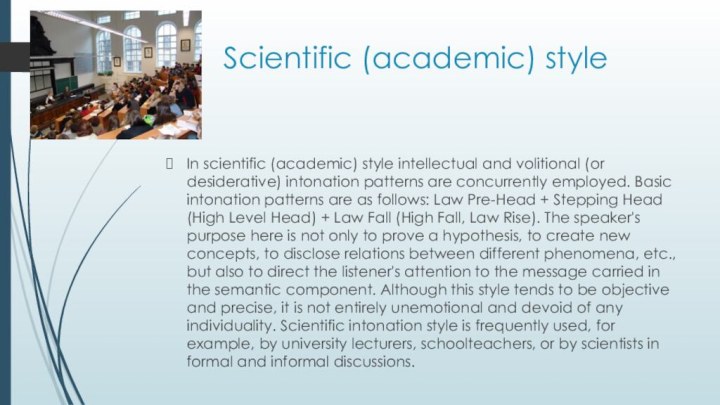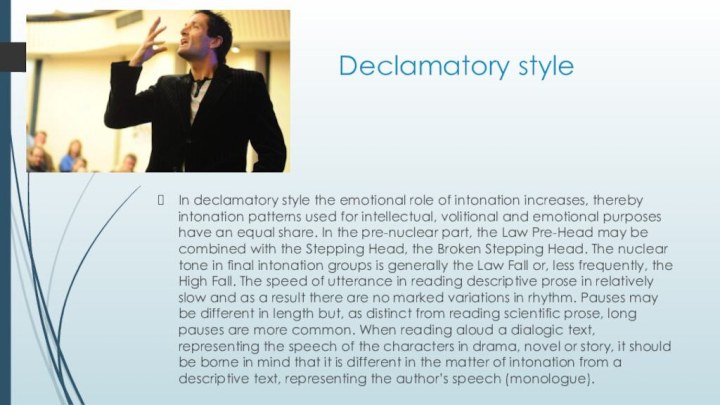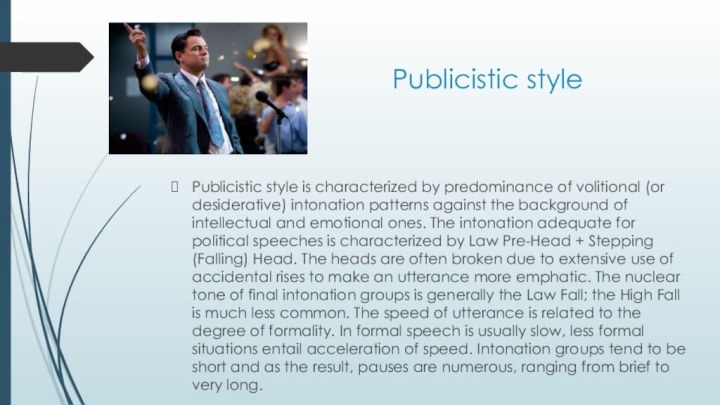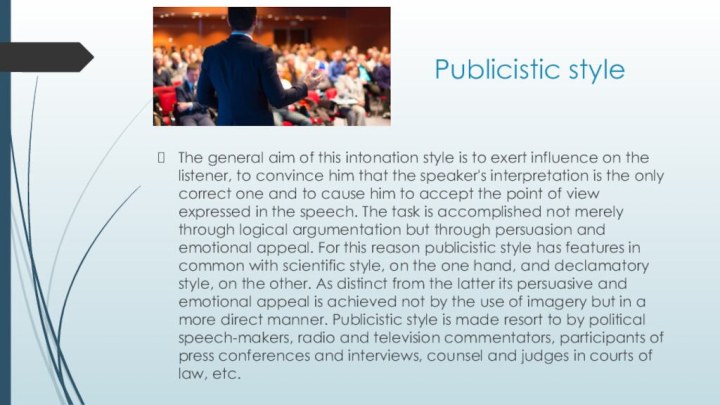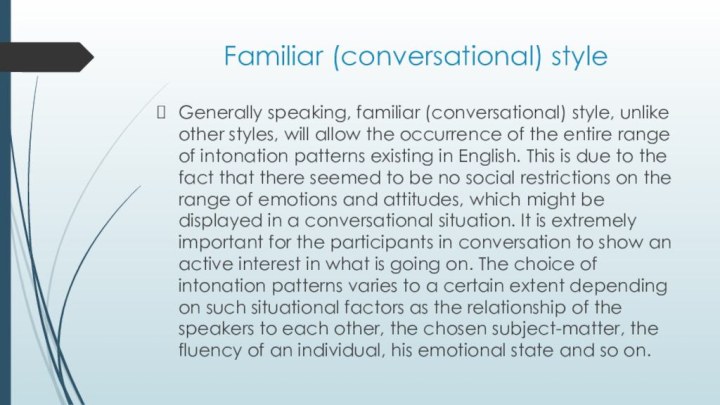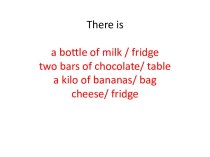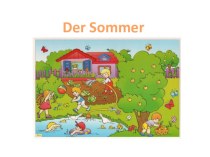Слайд 2
Extra linguistic factors
- the aim of the utterance
(purpose);
- the speaker’s attitude;
- the form of the communication
(monologue, dialogue)
- the use of a form of speech (discussion, conversation, lecture)
- the degree of formality (friendly, official)
- the social status of the speakers and their relation to each other;
- the degree of spontaneity (prepared, unprepared, reading aloud);
- speaker’s individuality;
- social prominence;
- range of intelligibility;
- sex and age of the speaker.
Слайд 3
We shall analyze the styles according to Socolova’s
classification.
1. Informational (formal);
2. Scientific (academic);
3. Declamatory;
4. Publicistic;
5. Familiar (conversational).
Слайд 4
there are three types of information present in
communication:
- intellectual information
- emotional and altitudinal (modal) information
- volitional
and desiderative information
Intonation plays a central role in stylistic differentiation of oral texts.
There are three types of intonation patterns used in oral communication:
- intonation patterns used for intellectual purposes
- intonation patterns used for emotional and attitudinal purposes
- intonation patterns used for volitional desiderative purposes.
Слайд 5
Informational (formal) style
is characterised by the predominant
use of intellectual intonation patterns. The characteristic feature of
informational style is the use of Law Pre-Head + Falling Head + Law Fall (Law Rise), normal or slow speed of utterance and regular rhythm. It occurs in formal discourse where the task set by the sender of the message is to communicate information without giving it any emotional or volitional evaluation. This intonation style is used, for instance, by radio and television announcers when reading weather forecasts, news, etc. or in various official situations. It is considered to be stylistically neutral.
Слайд 6
Scientific (academic) style
In scientific (academic) style intellectual
and volitional (or desiderative) intonation patterns are concurrently employed.
Basic intonation patterns are as follows: Law Pre-Head + Stepping Head (High Level Head) + Law Fall (High Fall, Law Rise). The speaker's purpose here is not only to prove a hypothesis, to create new concepts, to disclose relations between different phenomena, etc., but also to direct the listener's attention to the message carried in the semantic component. Although this style tends to be objective and precise, it is not entirely unemotional and devoid of any individuality. Scientific intonation style is frequently used, for example, by university lecturers, schoolteachers, or by scientists in formal and informal discussions.
Слайд 7
Scientific (academic) style
Attention is focused on a
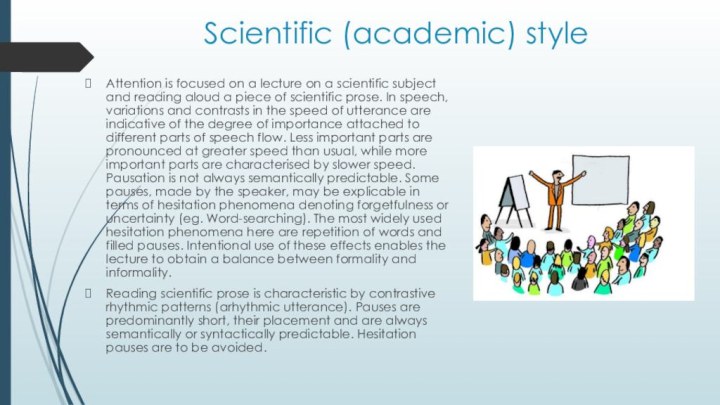
lecture on a scientific subject and reading aloud a
piece of scientific prose. In speech, variations and contrasts in the speed of utterance are indicative of the degree of importance attached to different parts of speech flow. Less important parts are pronounced at greater speed than usual, while more important parts are characterised by slower speed. Pausation is not always semantically predictable. Some pauses, made by the speaker, may be explicable in terms of hesitation phenomena denoting forgetfulness or uncertainty (eg. Word-searching). The most widely used hesitation phenomena here are repetition of words and filled pauses. Intentional use of these effects enables the lecture to obtain a balance between formality and informality.
Reading scientific prose is characteristic by contrastive rhythmic patterns (arhythmic utterance). Pauses are predominantly short, their placement and are always semantically or syntactically predictable. Hesitation pauses are to be avoided.
Слайд 8
Declamatory style
In declamatory style the emotional role
of intonation increases, thereby intonation patterns used for intellectual,
volitional and emotional purposes have an equal share. In the pre-nuclear part, the Law Pre-Head may be combined with the Stepping Head, the Broken Stepping Head. The nuclear tone in final intonation groups is generally the Law Fall or, less frequently, the High Fall. The speed of utterance in reading descriptive prose in relatively slow and as a result there are no marked variations in rhythm. Pauses may be different in length but, as distinct from reading scientific prose, long pauses are more common. When reading aloud a dialogic text, representing the speech of the characters in drama, novel or story, it should be borne in mind that it is different in the matter of intonation from a descriptive text, representing the author’s speech (monologue).
Слайд 9
Publicistic style
Publicistic style is characterized by predominance
of volitional (or desiderative) intonation patterns against the background
of intellectual and emotional ones. The intonation adequate for political speeches is characterized by Law Pre-Head + Stepping (Falling) Head. The heads are often broken due to extensive use of accidental rises to make an utterance more emphatic. The nuclear tone of final intonation groups is generally the Law Fall; the High Fall is much less common. The speed of utterance is related to the degree of formality. In formal speech is usually slow, less formal situations entail acceleration of speed. Intonation groups tend to be short and as the result, pauses are numerous, ranging from brief to very long.
Слайд 10
Publicistic style
The general aim of this intonation
style is to exert influence on the listener, to
convince him that the speaker's interpretation is the only correct one and to cause him to accept the point of view expressed in the speech. The task is accomplished not merely through logical argumentation but through persuasion and emotional appeal. For this reason publicistic style has features in common with scientific style, on the one hand, and declamatory style, on the other. As distinct from the latter its persuasive and emotional appeal is achieved not by the use of imagery but in a more direct manner. Publicistic style is made resort to by political speech-makers, radio and television commentators, participants of press conferences and interviews, counsel and judges in courts of law, etc.
Слайд 11
Familiar (conversational) style
The usage of familiar (conversational)
style is typical of the English of everyday life.
It occurs both within a family group and in informal external relationships, namely, in the speech of intimate friends or well-acquainted people. In such cases, it is the emotional reaction to a situational or verbal stimulus that matters, thereby the attitude- and emotion-signalling function of intonation here comes to the fore. Nevertheless, intellectual and volitional intonation patterns also have a part to play. In informal fluent discourse, there are examples of utterance where the effect of intellectual intonation is neutralized.
Слайд 12
Familiar (conversational) style
Generally speaking, familiar (conversational) style,
unlike other styles, will allow the occurrence of the
entire range of intonation patterns existing in English. This is due to the fact that there seemed to be no social restrictions on the range of emotions and attitudes, which might be displayed in a conversational situation. It is extremely important for the participants in conversation to show an active interest in what is going on. The choice of intonation patterns varies to a certain extent depending on such situational factors as the relationship of the speakers to each other, the chosen subject-matter, the fluency of an individual, his emotional state and so on.
